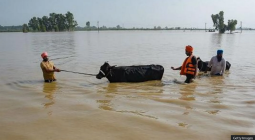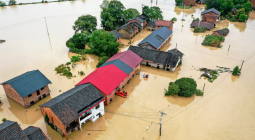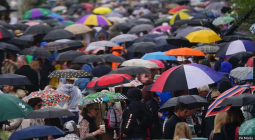How Asia's 5,000-year-old rice terraces are inspiring modern flood control

Parks, roofs and riverbanks mimicking the long-used agricultural form are helping Asian cities absorb, hold and purify rainwater.
One of Kotchakorn Voraakhom's most memorable moments growing up in Bangkok in the 1980s was playing in floodwaters in a small boat built by her father in front of her home.
"I was so happy that I didn't need to go to school because we didn't know how to get to it," recalls Voraakhom, a landscape architect based in the Thai capital.
But nearly 30 years later, flooding turned from a fun childhood recollection to a devastating experience. In 2011, Voraakhom and her family – along with millions of others in Bangkok – found themselves "displaced and homeless" when floods ploughed through swathes of Thailand and poured into the metropolis.
They were the country's worst floods in decades, a nationwide disaster which lasted more than three months and killed more than 800 people. Scientists later linked the flooding to increased rainfall triggered by human-caused greenhouse gas emissions.
The disaster deeply shook Voraakhom, who believed it was time to use her expertise to do something for her hometown. She founded her own landscape architecture firm, Landprocess, which over the past decade has designed parks, rooftop gardens and public spaces in and around the low-lying city to help its people increase their resilience to flooding.
Perhaps her most intriguing design so far has been an enormous nature-laden university roof inspired by rice terraces, a traditional form of agriculture that has been practised in Asia for some 5,000 years.
Thailand, China and other Asian countries are vulnerable to climate impacts. China has this year been hit by its highest number of significant floods since records began, while Thai farmers are exposed to rising heat, drought and flooding due to climate change.
The university roof designed by Voraakhom is part of a wider trend in Asia that is seeing architects seek inspiration from the region's rice terraces and other agricultural heritages to help urban communities reduce waterlogging and flooding. Examples range from adapted wetland parks in Chinese cities to homes in Vietnam with rice paddy-inspired rooftops.
At Thammasat University, north of Bangkok, tiers of small paddy fields cascade down from the top of the building along Voraakhom's green roof, allowing the campus to collect rainwater and grow food.
There are four ponds around the building to catch and hold the water flowing down. On dry days, this water is pumped back up using the clean energy generated by the solar panels on the roof and used to irrigate the rooftop paddy fields.
When the roof was built in 2019, it became Asia's largest urban rooftop farm, with 7,000 sq m (75,000 sq ft) of its total 22,000 sq m (237,000 sq ft) dedicated to organic farming.
Compared to a design made of concrete, the green roof can slow down runoff – excess rainwater that flows to the ground, a big problem for Bangkok – by about 20 times, according to estimates from Voraakhom. It can also lower the temperature inside the building by 2-4C (3.6-5.4F) during Bangkok's notoriously hot summer, she says.
Rice terraces are layer upon layer of paddy fields usually created by smallholder farmers along the sides of hills and mountains to maximise the use of land. They can be found in many Asian countries including China, Japan, Thailand, Vietnam and the Philippines. Their origin can be traced back to the Yangtze River Basin in China more than 5,000 years ago.
While their shapes and sizes may vary, all rice terraces are built to follow natural contour lines, which means each layer has equal elevation above sea level. This feat enables them to collect and hold rain and use it to nurture the soil and crops. Some rice terraces, such as those of the Hani people in southern China, overlook rivers, allowing the tiered soil to reduce, decelerate and purify excess rainwater washing down from the top of the mountain before it flows into the valley.
Such indigenous know-how, passed down by generations of small-scale farmers, can hugely benefit Asian cities when it comes to handling rainstorms, according to Yu Kongjian, a professor of landscape architecture at Peking University in Beijing and the brains behind China's "sponge city" concept. (Read more about world's spongiest cities.)
Chinese cities – as well as many others in Asia – have a monsoon climate, which is characterised by rainy summers and drier winters. They can get up to a third of their annual rainfall – 300-500mm (11.8-19.7in) of rain – within a day, according to Yu. These huge downpours mean their flood-control measures need to be based on localised ways of adaptation tested and proven over thousands of years, he argues.
Rice terraces are one of the pillars of Yu's spongy city theory, which urges cities to turn to soil and greenery – not steel or cement – to solve flooding and excess rainfall problems. According to him, rainwater should be absorbed and retained at the source, slowed down in its flow and then adapted to where it ends up. Rice terraces deal with mitigating floods at the source, Yu says.
Since 1997, he has designed more than 500 "sponge city" projects featuring the terracing element across China. Studies have shown that some of them are bringing impressive impacts.
The Yanweizhou park, for example, completed in 2014 in Jinhua, Yu's hometown, has a rice-terrace-like bank planted with grasses that can adapt to an underwater environment. The "spongy" feature is capable of reducing the park's yearly maximum flood level by up to 63%, compared with a concrete one, a 2019 paper found.
Such designs can also filter floodwater, which is often contaminated by sewage, chemicals and other pollutants. Another of Yu’s projects, Shanghai Houtan Park, is situated on a piece of once highly polluted land that used to house a landfill site for industrial waste. Since its establishment in 2009, each hectare of the park, which also features Yu's terracing element, is capable of purifying 800 tonnes of heavily polluted water per day, Yu reported in a 2019 paper after conducing multiple on-site tests. The water in the park now meets the third-category standard for water in China – clear enough for fish to live in – the paper said.
The terracing trend has also sprouted in Vietnam. Doan Thanh Ha, founder and principal architect of Hanoi-based firm H&P Architects, has combined traditional agricultural wisdom with his designs of eco-friendly buildings since 2009. His works include a three-storey home with a rice terrace-inspired roof where the owner can grow crops, as well as a low-cost floating house made with bamboo that poorer households could use to adapt to flooding and sea-level rise. (Read about how floating bamboo houses in the Philippines are already helping locals withstand floods, rising water levels and typhoons).
The terraced rice fields in Vietnam are an example of local knowledge that carries deep understanding of natural laws, particularly those of water, Doan says.
This kind of local knowledge can also play a "significant role" in helping modern communities maintain biodiversity and ecosystems, as well as responding to climate change, he says.
Yu agrees. As global warming brings heavier downpours to Europe, for example, the use of terraced rice fields could even be transplanted to cities like London, he says. "Any slope or slanting surface can be turned into nature-filled terraces to absorb rainwater."
Wake-up calls
Asian cities – many vast and densely populated – have started rethinking their rainwater-management strategies in recent years as they face the double whammy of decades of breakneck urbanisation and climate change.
In many places, monsoon downpours are getting more intense, typhoons are becoming more destructive and sea levels are rising. Some cities, like Jakarta and Ho Chi Minh City, are also sinking rapidly due to the loss of groundwater and the weight of buildings.
In many of these cities, rainwater cannot penetrate the paved surfaces, which means the soil underneath does not have the chance to soak up and store rainwater to contribute to the natural water cycle system, says Lei Yanhui, a teaching fellow of urban planning and design at the Xi'an Jiaotong-Liverpool University in Suzhou, China.
Moreover, some cities' drainage systems do not separate rainwater from sewage and are prone to overloading and overflowing during storms, Lei says. (The same problem occurs in the UK, as explained in our recent article about the country’s struggle with sewage pollution).
In summer 2012, the year after Thailand's massive flooding, extreme downpours pounded Beijing, resulting in a record-breaking 460mm (18in) of rain in the space of 18 hours. The event caused 79 deaths and around $1.6bn (£1.2bn) in damages.
The crisis marked a watershed moment. "After that, China started to pay proper attention to [urban] rainwater drainage and flood prevention," says Shao Zhiyu, a professor of urban flood control at Chongqing University in southwest China.
In 2014, China officially adopted the "sponge city" concept as a national programme, with 16 cities chosen as "pilots" in the following year to try out the model. They included Chongqing, a mountainous megacity in central China with a population of 32 million.
"We used to think that we should control floods. But now we have realised that floods cannot be controlled but [have to be] adapted to because the power of nature is too great," says Shao.
Shao, who has an engineering background, was a member of a team tasked to design a "spongy" new river-side area in Chongqing. The area includes plant-filled terraces on slopes.
"The design was initially intended to purify rainwater before it flows into the river, but it is also capable of reducing the peak flood level, as long as the rainfall is not too extreme," Shao says.
For Voraakhom in Bangkok, rice terraces are a reminder of the simple yet adaptive lifestyle of her ancestors who lived in harmony with water and seasonal changes for millennia.
Rain used to be a welcoming occurrence to the Thais because it nourished the land and allowed rice to grow, "but we are changing the best agricultural area in the world into the worst city you can imagine, which is Bangkok", she says.
The city of 11 million, situated 1.5m (4.9ft) above sea level, has only seven sq m (75.3 sq ft) of public green space per capita, one of the lowest amounts in Asia. It hadn't built a single new public park for 30 years until 2017 when the 11-acre (4.5 hectare) Chulalongkorn Centenary Park – also designed by Voraakhom with flood retention at its heart – opened.
The park is built at an angle of three degrees, which enables it to funnel storm water from its highest point into a retention pond. In total, it is able to hold a million gallons (4.5 million litres) of water – roughly the equivalent of 1.5 Olympic-size swimming pools.
"Building urban resilience is the only way [for us] to survive," says Voraakhom.
Plants vs pipes
As nature-based solutions – embodied by "green" infrastructure like rice-terraced-inspired river banks, urban parks and trees and green roofs – gather limelight, there have been debates over whether they can really handle more and more relentless storms compared with more conventional "grey" infrastructure such as dams and pipes.
Wang Yuhong, a professor of engineering at the Hong Kong Polytechnic University, thinks green infrastructure can be "a meaningful supplement" to grey infrastructure, if applied to suitable geographies.
Designs based on rice terraces, he says, could benefit cities with mountains, such as Hong Kong, where rainwater can wash down steep slopes rapidly.
Famous for its urban jungle view from the top of the Victoria Peak, Hong Kong has built a huge concrete tunnel to intercept rainwater at the mid-levels of the island and drain it into the sea to prevent the city centre below from being inundated.
"But this rain-collecting method is expensive," Wang notes. The project, completed in 2012, cost nearly 3.9 billion Hong Kong dollars (£390m/$504m). "If we copy the rice-terrace principle, we can retain the rainwater in the mid-levels in different ways, such as by building rain gardens. For many cities, this would be a more economical method."
Still, the idea could be too costly, technically challenging and emissions intensive in some places, such as those that require concrete structures to be constructed from the ground to mimic slopes, he adds.
In fact, bringing any kind of green infrastructure to the world's densest cities won't be easy. Asian cities are compact, "therefore it is very hard to find large enough spaces to act as 'sponges' to take in floodwaters," according to Wang.
A more effective way is to build massive underground vaults to store stormwater as Hong Kong and Tokyo have done, Wang says. He and his team are also working on a solution to allow cities to store rainwater under roads using "porous" paving stones.
But "artificial facilities" such as underground storage tanks have drawbacks, as Lei points out: "They are isolated and cannot help much in establishing a natural rainwater recycle system the same as [those based on] rice terraces."
Shao says that green infrastructure can show obvious effects in flattening peak flood levels for the types of high rainfalls seen once every three to five years. "But for more severe [storms], such as those that occur once in ten years or more, we still need to rely on grey infrastructure, such as urban drainage, pump stations and flood gates," she says.
Sponge city infrastructure can also be combined with other mechanisms to reduce flooding, however, notes Shao. For example, systematic urban planning can divert floodwaters from a few main roads to less important roads so that the city can still perform basic functions, particularly rescue tasks, during flooding, she adds.
For Yu, the sponge city concept is not a total rejection of grey infrastructure. He says cities should prioritise using green infrastructure, "but if it is really impossible, then we can use pipes".
Beyond the discussions over green or grey infrastructure, however, many agree that cities need to take a leaf out of their ancestors' experience in adapting to the natural world and its changes.
Instead of fearing and blocking floods, humans should "befriend water” to move forward in a more unpredictable climate, Yu says. This means cities should redesign their low-lying areas – such as by turning them into terraced wetlands – to allow them to be safely flooded during heavy rainfall.
The move would not only keep cities’ core functions safe during natural disasters, Yu says, but also establish a natural rainwater recycling system, something the urban concrete jungles of today currently lack.





